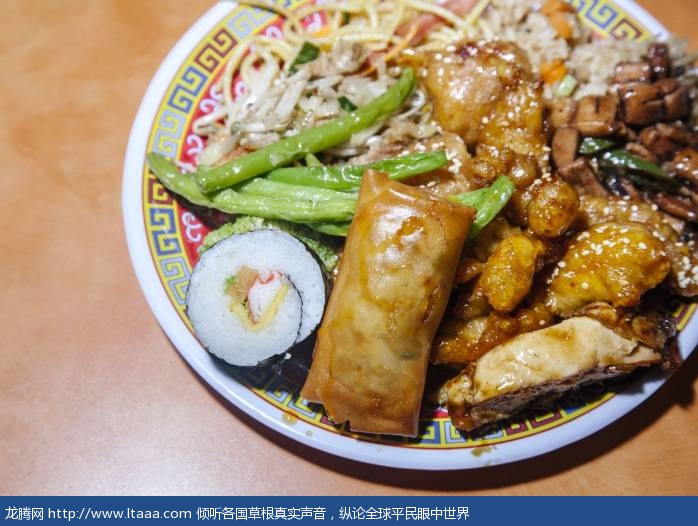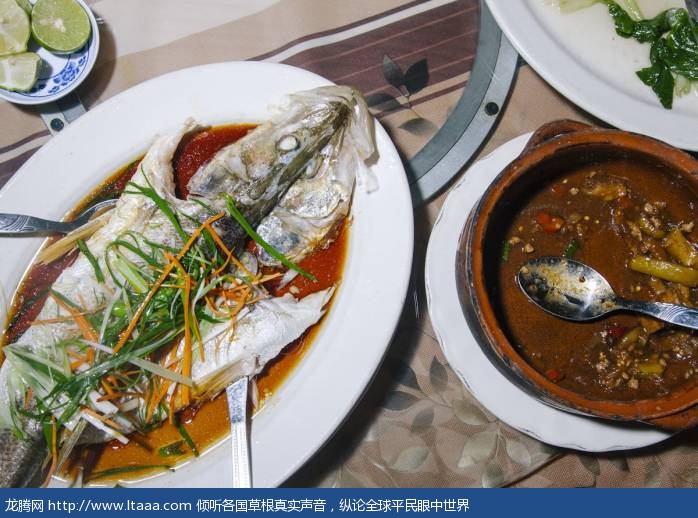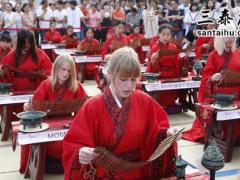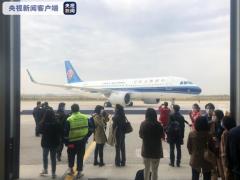中餐如何成为了墨西哥城主食 [美国媒体]
朴素的中国自助餐现已经成功席卷墨西哥城,当中国餐馆像雨后春笋般在洛杉矶和纽约城拔地而起的时候,你这才真正注意到他们已经无处不在了。这些餐馆布局都有规律的每隔6个街区一个餐馆。餐馆装饰着红色和金色普通食堂大厅胶木餐桌和长长的保温餐桌贯穿他们的中心。吃一顿饭约70至100比索(约合5.50美元- 3.80美元)。
-------------译者:水 古 月-审核者:slmingsl------------
Understated and resoundingly regular Chinese steam table buffets are woven into the tapestry of Mexico City so seamlessly it's not until you start noticing them — like weed dispensaries in Los Angeles or a prolific New York City graffiti tag — that you realize they're all over the place. It's a standard model with as many as one restaurant for every half-dozen blocks: nondescxt cafeteria halls decorated in red and gold with Formica tables and long steam tables running through their centers an all-you-can-eat prix fixe for around 70 to 100 pesos (or roughly $3.80 to $5.50 USD).
朴素的中国自助餐现已经成功席卷墨西哥城,当中国餐馆像雨后春笋般在洛杉矶和纽约城拔地而起的时候,你这才真正注意到他们已经无处不在了。这些餐馆布局都有规律的每隔6个街区一个餐馆。餐馆装饰着红色和金色普通食堂大厅胶木餐桌和长长的保温餐桌贯穿他们的中心。吃一顿饭约70至100比索(约合5.50美元- 3.80美元)。
-------------译者:水 古 月-审核者:水 古 月------------
But whose food is this? Under the warming lamps in their compartmentalized pans sit glistening sesame chicken string beans wok-fried with bits of indiscernible protein beef with orange flavor. There are French fries fried plantains and fried chicken wings. The first time I visited a Chinese steam table buffet in Mexico City I filled my plate with fried rice egg rolls and batons of shellacked spareribs which reminded me of the corner take-out joints in Brooklyn. The flavors here were both sweeter and spicier than their "Americanized" Chinese counterparts geared for the Mexican palate. Other touches reflected the local terrain: a dish of nopales and beef the cactus paddles standing in for celery; fresh papaya at the end of the buffet line for dessert. Most customers were drinking agua frescas of jicama and horchata. The fortunes cracked from the cookies at the end of the meal were in Spanish。
但是这些餐馆里都是哪国食物呢?厨房里灯光明亮,各式平底锅里烹饪着香喷喷的芝麻鸡肉,咖啡豆油煎肉片,西柚风味儿的牛排。这里有炸薯条、炸巴蕉和炸鸡翅膀。我第一次到中国餐馆吃饭的时候,我的盘子里装满了炒饭、蛋卷和骨肉相连,这让我想起了在布鲁克林借拐角买的脆骨。这里的风味儿比被美国本土化的中国餐馆更甜、更辣。一盘墨西哥式牛肉,为了映衬沙漠氛围,盘子里装饰着仙人掌和船桨。新鲜的木瓜小吃在自助餐区末端,大多数顾客都会喝木薯饮料。西班牙开的餐馆都快没生意做了。
-------------译者:水 古 月-审核者:水 古 月------------
A line of condiments sat at the end of the buffet: Sriracha soy pickled jalapeños dried chile in a seething orange oil and like every eatery in Mexico City regardless of cuisine the requisite bowl of lime wedges. Is the restaurant Chinese? Chinese-Mexican? Mexicanized-American-Chinese? In other words what route did the sesame chicken fly to end up as a de rigueur lunch in Mexico's federal district?
自助餐厅里一排排调味罐整齐排列着:有辣椒酱、酱油、酸辣泡椒。就像每一个在墨西哥城的便利餐厅一样,菜品烹饪不拘一格和契型碗这两样必不可少。这是纯中式餐馆吗?或者是中墨餐馆?又或者是中墨美三国混合餐厅?换句话说中国的芝麻鸡是在走什么路线,最终飞到在墨西哥城的餐厅里?
-------------译者:水 古 月-审核者:水 古 月------------
The Chinese have a long history in Mexico and today are a significant presence as a resident ethnic group. Large-scale migration started in the late 19th century when Mexico was a rapidly expanding country in need of cheap labor. According to immigration records more than 60000 Chinese migrated to work in the fields mines and to set railroads. Another catalyst was the United States' Chinese Exclusion Act of 1882 which slammed doors shut and forced traveling hopefuls to divert their paths further south to Mexico. By 1920 the Chinese were the second largest immigrant group in Mexico and had diffused to all corners of the country. Dense communities put down roots in northern border towns like MexiCali in port cities of Veracruz and to the south in Chiapas. Mexico enacted its own exclusionary measures in 1930 launching an anti-Chinese campaign and in 1931 full-on expulsion.
中国人在墨西哥有着悠久的历史,而现在作为墨西哥人口的重要组成部分。大规模移民始于19世纪晚期当时墨西哥是一个迅速扩大的国家,急需大量廉价劳动力。根据移民记录超过60000中国人迁移墨西哥,工作领域包含矿山铁路等。另一个催化剂是美国1882年的排华法案关闭了中国人去美国的大门,迫使一些人转移南到墨西哥。到1920年中国在墨西哥是第二大移民群体。华人已经扩散到墨西哥的各个角落。密集的华人社区扎根在北部边境城镇与墨西卡利一样在韦拉克鲁斯州的港口城市和向南在恰帕斯。墨西哥开始制定自己的反华措施并在1930年发起一场反华活动,1931年全面驱逐华人。
-------------译者:水 古 月-审核者:水 古 月------------
Those ejected were officially invited back in the '50s but there were some Chinese who stayed. Buttressed with lixs to Chinese wholesalers on the mainland and in the U.S. they established a "transnational commercial orbit" as Robert Chao Romero describes in his book The Chinese in Mexico 1882-1940. This intra-ethnic network aided labor contracting and commercial trade across multiple borders. Within their local communities they opened groceries stocked Chinese ingredients and built small restaurants to feed a growing diaspora.
早在20世纪50年代的时候,这些华人被正式邀请返回墨西哥但只有少数中国人愿意留下来。在中国大陆和美国华人批发商的支持下,他们建立了一个“跨国商业轨道“,正如Robert Chao Romero 在他的《中国人在墨西哥:1882-1940》中所描述的那样。这个贸易网络系统里的劳务输出和商业贸易跨越多个边界。在当地社区他们开设杂货店批发贸易建立小餐厅来满足不断增长的移民需求。
Some entrepreneurial Chinese were already versed in American-style short-order cooking and in the 1920s opened "cafes de chinos" that specialized in cafe con leche flanked by pan dulce and quick cheap meals. These utilitarian restaurants were Mexican equivalents to the American coffee shop serving a bricolage menu of eggs pancakes and coffee; Mexican dishes like enchiladas and tamales; and nominally Chinese dishes like chop suey and fried rice.
一些中国企业已经精通美式快餐的烹饪。在1920年代在咖啡馆开了“斜纹裤咖啡馆”专门供应甜酒和快速廉价的食物。这些功利的小餐馆是墨西哥模仿美国的咖啡店能够卖鸡蛋薄饼和咖啡墨西哥菜诸如辣酱玉米饼馅和玉米粉蒸肉。以及名义上的中国菜比如炒杂烩菜和炒饭。
-------------译者:水 古 月-审核者:水 古 月------------
These eateries grew in popularity offering an affordable round-the-clock respite for urban laborers and new waves of immigrants. They reached their pinnacle of popularity in the 1950s. The streets surrounding the Zócalo in Mexico City were full of them marked by bobbing red and gold paper lanterns. It's here that Mexico City's first Chinatown "Barrio Chino" (note "Chino" in Spanish is often used as a blanket term that refers to anyone of Asian descent corralling a diverse group of ethnicities) coalesced on a two-block stretch of the Centro Historico serving Americanized Chinese and Mexican-Chinese mashups.
这些餐馆越来越受到人们的欢迎,能全天候的为都市劳工和新来移民提供负担得起的食物和服务。在1950年代他们是最受欢迎的。墨西哥城宪法广场的周围街道都布满了这些餐馆,挂满了红色和金色的纸灯笼。就是在这里建立了墨西哥城的首个“唐人街”,横跨旧城区的两个街区,提供美国化的中国菜和墨西哥中国菜。
Luis Chiu the young chef of one of DF's Chinese restaurant standouts Asia Bay traces his lineage back to these early peregrinations. His great-grandfather was part of a wave that came to Mexico during the Revolution and was privy to the anti-Chinese sentiment generated by extreme revolutionary nationalism. He left. Decades later his son Chiu's grandfather landed in Veracruz eventually making his way to Mexico City where in 1947 he opened Shanghai one of the first restaurants in Barrio Chino. It's still open。
作为墨西哥联邦区着名的中餐馆亚洲湾的年轻大厨,Luis Chiu 将自己的血统追溯到这些早期的旅程。大革命期间他的曾祖父是墨西哥移民潮中的一员,而且他知悉了极端民族主义分子将掀起反华浪潮,所以他离开了。他的儿子,也就是Chiu的祖父最终来到了韦拉克鲁斯(墨西哥城市),并于1947年抵达墨西哥城,然后在唐人街开办了首批餐馆之一的“上海餐馆”。现在依然在营业。
-------------译者:道角-审核者:吴春宝------------
Luis Chiu's father in the Barrio Chino 1992. He's standing in front of Shanghai the family's restaurant that opened in 1947. Photo: Courtesy the Chiu family
路易斯.邱的父亲1992年在唐人街。这是家庭餐馆“上海”在1947年开业时候的照片,他正站在自己餐馆的前面。。图片:彬彬有礼的邱氏一家
"When he started he couldn't find any Chinese ingredients so the only thing they could make was chopped suey and all those bad quick Chinese dishes" Chiu says. But the restaurant became a cultural hub. "It was the first stop Chinese people would go when they landed in Mexico" Chiu says. "It used to have a casino an underground one where they would play mahjong with the restaurant upstairs." His father continued in the industry opening a number of cafes throughout the city that served both Mexican and Chinese dishes,
“当他开业时发现找不到任何中国食材,他们只能做炒杂碎和那些品味差、出菜快的中国菜”,邱说道。但是这个餐馆成了一个文化中心。“它成了中国人来到墨西哥后的第一站”,邱说,“过去有个赌场,在地下,他们在那儿玩麻将,餐馆就在楼上”。他的父亲继续从事这行,在全城开了许多咖啡馆,提供墨西哥菜和中国菜。
-------------译者:道角-审核者:水 古 月------------
His restaurant Asia Bay sits in a stately house on a cosmopolitan strip of Colonia Condesa sharing the block with examples of other global cuisines: a Japanese ramen house a modern cerveceria and an Argentine grill. Across the street an Irish bar blares Rick Astley and the red lanterns overhead seem to bob in time. With Mexico City's rising middle class and according to the New York Times a foreign-born population that's doubled between 2000 and 2010 new types of cuisine are entering the market. People are hungry for food that is not Mexican. And at Asia Bay the waiters in chapped black leather aprons take orders for lo mein and General Tso's chicken from Canadian tourists and Mexican businessmen on extended lunch breaks.
他的餐馆亚洲湾坐落在大都会地带Colonia Condesa一座富丽堂皇的房子里,和它共一街区的是全球其它菜系代表:一家日本拉面,一家现代啤酒屋,还有一家阿根廷烧烤。街对面,一家爱尔兰酒吧嘈杂地放着Rick Astley 的歌,头上的红灯笼似乎都在打拍子。随着墨西哥中产阶级的兴起,还有在2000年至2010年间增加了一倍的外国出生人口——据纽约时报,新的菜品开始进入市场。人们渴望尝试非墨西哥食物。在亚洲湾,侍者穿着有裂痕的皮裙,在延长的午休时间里承接加拿大游客和墨西哥商人点捞面和左宗棠鸡的订单。
-------------译者:布拉格鸽子蛋-审核者:水 古 月------------
But on some tables wayward dishes appear. There are plates of minced pork with salted fish loins fragrant cumin lamb smashed cucumbers that vibrate with black vinegar and xio long bao their rich liquified aspic centers cloaked by translucent skins. They signal that at Asia Bar there are actually two menus two cuisines at play: traditional Mexican-Chinese cuisine that looks a lot like the Chinese-American catalog and —
但在一些桌上出现了许多个性的盘子。有猪肉碎拼咸鱼、香喷喷的孜然羊肉、黑醋拍黄瓜,还有小笼包,半透明的皮儿里面包着丰富的呈液体状的肉馅儿。在亚洲酒吧他们表明其实有两种菜单,展示了两种菜系:看起来像美国中餐的墨西哥中国菜。
--------------译者:huangjian_1984-审核者:水 古 月------------
Chiu grew up speaking Spanish and a bit of Cantonese. At home his mom cooked Mexican and Chinese dishes: chile rellenos one night beef with bittermelon the following. It was more bifurcated rosters than culinary fusion though there certainly was borrowing on both sides. Chiu feels at home in the cross-cultural overlap. "Sometimes I think that maybe chilaquiles were invented in a Chinese cafeteria" he says. "There's no research to back it up but chop suey is kind of like chilaquiles. You cut everything to strips and fry it up quickly taking bits of things putting them together and making a dish."
邱说西班牙语长大并会说一点广东话。家里某一天晚上,他妈妈做墨西哥和中国混合的菜:辣椒菜,牛肉混搭木瓜。感觉是两极分化多过厨艺的融合,虽然这里肯定借鉴了双方的一些特点。邱感觉到了家里的这次跨越文化的重叠。他称:“有时候我认为鸡肉青豆玉米饼可能发明于中国,但没有人研究它的起源。但是剁碎是一种类似鸡肉青豆玉米饼的制作方式。你可以把任何东西切成条状并快速油煎,然后混合许多其他的东西做成一道菜。
Chiu grew up in his family's restaurants. Once he started studying gastronomy and cooking professionally he had Quixotic dreams of bringing refined Chinese food to the Mexican masses. He studied in China and returned home. He quickly realized that serving elevated takes of classics Chinese dishes wouldn't work because most Mexicans had never experienced the originals.
邱在他家庭餐馆里长大。曾经尝试学习专业的烹饪和烹调厨艺。他有着不切实际额的梦想把改良的中国餐饮推荐给大量墨西哥人。他去中国学习厨艺回到家里后很快意识到提供改良的经典中国餐会失败因为很多墨西哥人没有吃过原味的。
-------------译者:布拉格鸽子蛋-审核者:道角------------
The two-menu sextion at Asia Bay is Chiu's compromise with the city. He wanted to serve traditional dishes with no deviations and no flavors manipulated for the Mexican palate. It was a struggle. When he worked at his family's restaurant Shanghai he tried to change some of the dishes along the way tweak them to improve them and people got angry. "People would come and say 'I used to come here when I was a kid 40 years ago. But this isn't the same. It tastes different. Did you guys change chefs?'" he laments. "People go there now because it tastes like it did 40 years ago —
在亚洲湾选择两种菜单是邱先生与这个城市的妥协。他想提供正宗的中国传统菜肴,不掺杂任何墨西哥口味。这是场抗争。当他在自家的“上海餐馆”工作时,他试着去改变一些菜式,不断地调整并提高菜品,然而人们最终愤怒了。“大家会跑过来问我,“40年前我还是个孩子时经常来这里吃。但现在不一样了,完全不是当年那个味儿。你们换厨师了吗?””邱先生感慨道,“人们来这里吃饭,仅仅是因为味道与40年前相同。”
-------------译者:布拉格鸽子蛋-审核者:龙腾翻译总管------------
This illuminates a key element of the Chinese steam table phenomenon: visibility. In Chiu's experience most Mexicans have a hard time ordering Chinese dishes from a printed menu. "People don't know what they are choosing" he says. "They don't want to read a menu and ask 'What is this?' Or choose at random and when the dish comes it's totally different than what they wanted. With the steam tables they can see the dishes look for something that looks familiar and choose it." It is a visual representation that allows for individual sextion much like the backlit photos of dishes in take-out joints.
这说明了中国保温餐桌现象的一个关键因素:可视性。在邱的经验中,大多数墨西哥人很难从印好的菜单中点中国菜。”人们不知道他们在选择什么,“他说。”他们不想指着菜单,问这是什么?要么就是随便选个菜,结果当上菜时,才发现完全不是他们想要的。而如果使用保温餐桌,他们可以看到这些菜,可以根据熟悉的菜品食材来寻找和选择。”这是一种可视的表现形式,允许个人选择,就像外卖餐馆里菜肴的逆光照片一样。
-------------译者:magicqueen99-审核者:龙腾翻译总管------------
Figuring out what worked best what translated at Asia Bay was an evolution. It started with more upscale versions of the Americanized-Mexican Chinese food on offer at the buffets. "We knew that is what most people would order" says Chiu "but we also wanted to offer real Chinese food for the Chinese community living here. So we created two menus one in Spanish one in Chinese. People would come and see other tables eating stuff that wasn't on the menu and they would ask for it. Chinese businessmen would start bringing their Mexican clients to the restaurant; they would return with their families and want the food they had with their Chinese friends. So we started to print Spanish on the Chinese menu. Then we started to see a lot of English speaking people —Australians Americans even Korean and Japanese who know how to read English but not Spanish — coming in so we started to print a Chinese-Spanish-English menu."
在亚洲湾找到什么方式奏效,菜单怎么翻译,是一个渐近的过程。这一进程始于餐厅向自助餐的食客打折出售更多高档的美国化墨西哥风味中国菜。“我们知道大部分顾客会点什么菜”老邱说,“但是我们仍然想为附近的华人社区提供正宗的中餐。所以我们就用中文和西班牙文各做了一份菜单。顾客们看到其他桌子上的食客在享用自己菜单上没有的菜肴时,常常也会要上一份。中国商人开始来这里宴请他们的墨西哥客户;当他们下次带家人一起来就餐时,就会点他们的中国朋友招待过的菜式。所以我们开始在中文菜单上加印西班牙语。后来我们这里渐渐地有很多讲英语的客户----美国人、澳大利亚人,甚至只会看英文而不懂西班牙语的韩国人和日本人也来了。于是我们就制作了中文-西班牙文-英文的三语菜单。”
-------------译者:道角-审核者:龙腾翻译总管------------
Some of the more classic renditions caught on. "People started to ask more and more for traditional dishes and leave the 'American-style' Chinese food behind. We used to have orange chicken on the menu for example and people stopped ordering it because they wanted hot plate pepper beef or Sichuan-style pork belly. Slowly slowly people's palates changed. That's part of our success I think bringing real Chinese food to the Western Mexican audience."
一些更经典的做派流行起来。“人们开始越来越多地点传统菜肴,撇弃‘美式中餐’。比如,过去我们菜单上有陈皮鸡,但人们不再点这道菜,因为他们想要铁板胡椒牛肉或四川爆肚。慢慢地,人们的品味变了。我想,我们部分成功了,给墨西哥食客带来真正的中餐。”
Today the Chinatown in Centro Historico is a theme park for tourists (if you can call it that — it's about one square block). The restaurants that fulfill the same role Shanghai restaurant did 50 years ago — providing the city's entry point for newly arrived immigrants — have moved further south. "It's not official" Chiu says "but Viaducto is where the Chinese residents in Mexico City call Chinatown." It's a south-centrally located residential neighborhood east of the city's central artery Calzada de Tlalpan. Most of the city's newest Chinese immigrants have concentrated there mostly from economically distressed regions in the Guangdong Province. Dotting the avenues are small unmarked groceries with shelves of rice and teas and petite bakeries selling Chinese pastries.
今天,在Centro Historico的唐人街已经成了旅游主题公园(如果你可以这么称呼它-它大约是一个方形街区)。50年前“上海”餐馆完成了相同角色——给新到来的移民提供城市的入口,它已经搬到更南的地方了。“这不是正式说法”,邱说,“但中国人在墨西哥城居住的Viaducto 被叫作唐人街。”它位于中南部住宅区,城市中心干道Calzada de Tlalpan的东面。大多数中国新移民聚集在那儿,大部分是从广东不发达地区来的。街道两旁点缀着没有招牌的小店,架子上摆着米饭和茶,还有卖中国糕点的小烘烤店。
-------------译者:道角-审核者:龙腾翻译总管------------
At one of the neighborhood's best-known restaurants Ka Won Seng there's a sign taped to the door scrawled in Spanish: "No hay comida mexicana café ni pan dulce" —"no Mexican food coffee or sweet rolls" reflecting the city's history and preference for the Chino-Mexicano coffee shop. The restaurant serves dim sum on weekend mornings. There are no roving carts; one must head to the counter where stacks of steamers and bamboo rounds cradle dumplings turnip cakes and niblets of pork rib in black bean sauce. During the afternoon the menu remains brilliant: roasted duck with shellacked mahogany skin whole fish steamed with ginger and scallions cold tofu in chile sauce electric green bok choy with garlic. Menu transcxtion for English-speakers at least is a game of telephone: "Berenjena con jarabe de pescado" reads as "eggplant with syrup of fish" and "gallina fina" is "fine chicken" but the flavors are exact translations.
在附近着名餐馆的其中一家, Ka Won Seng门上贴着标志,上面是潦草的西班牙字:“No hay comida mexicana café ni pan dulce”——“没有没有墨西哥食品,咖啡,或甜面包”,反映了城市的历史和这家中墨咖啡店的偏好。周末上午这家店会供应点心。没有流动餐车,人们必须去柜台,那里有成堆的蒸锅和竹屉蒸饺、萝卜糕、豉汁排骨。下午时分,菜单依然抢眼:酥红脆皮烤鸭、姜葱清蒸鱼、辣酱凉豆腐、蒜炒青菜。菜单翻译就像是电话游戏——至少对说英语的人是这样:"Berenjena con jarabe de pescado"读作“茄子糖浆鱼“,而”gallina fina“是”好鸡“,但是味道还是翻译得挺准确的。
译注:电话游戏,一种多人游戏,参与者依次向后一人复述一句话(只能讲一次),最后一人听到的话往往和第一人所说大相径庭。
-------------译者:布拉格鸽子蛋-审核者:龙腾翻译总管------------
Chiu has recently expanded his reign of Asia Bay to open two little dumpling shops in the city's newly established mixed-used foodie markets. The carefully pleated jiaozi speak to the city's well-traveled urbane sect hungry for something new. Over a meal at the city's sole Indonesian restaurant I ask Chiu if he anticipates phasing out the old Asia Bay menu in the future getting closer to his dream of serving unalloyed Chinese recipes. He takes a moment to think. "No. People still love sweet and sour chicken chow mein fried rice. They are classics. And in a way they are now traditional too."
邱最近扩大了亚洲湾餐馆的规模,在城市的新区开了两个小饺子店,与美食街混合经营。精心打褶的饺子令脚步匆忙、彬彬有礼而又饥肠辘辘的人们耳目一新。在这座城市唯一的印尼餐厅吃饭时,我问邱他是否希望到旧的亚洲湾菜单在未来会逐渐淘汰,从而更接近他提供正宗中国菜谱的梦想。他思考了一会儿。”人们仍然喜欢糖醋鸡,炒面和炒饭。它们是经典的。而且,在某种方式上,它们现在是种传统。”
版权声明
我们致力于传递世界各地老百姓最真实、最直接、最详尽的对中国的看法
【版权与免责声明】如发现内容存在版权问题,烦请提供相关信息发邮件,
我们将及时沟通与处理。本站内容除非来源注明五毛网,否则均为网友转载,涉及言论、版权与本站无关。
本文仅代表作者观点,不代表本站立场。
本文来自网络,如有侵权及时联系本网站。
图文文章RECOMMEND
热门文章HOT NEWS
-
1
Why do most people who have a positive view of China have been to ...
- 2
- 3
- 4
- 5
- 6
- 7
- 8
- 9
- 10
推荐文章HOT NEWS
-
1
Why do most people who have a positive view of China have been to ...
- 2
- 3
- 4
- 5
- 6
- 7
- 8
- 9
- 10



/cdn0.vox-cdn.com/uploads/chorus_asset/file/6528515/DF-Chinese-food.0.jpg)










